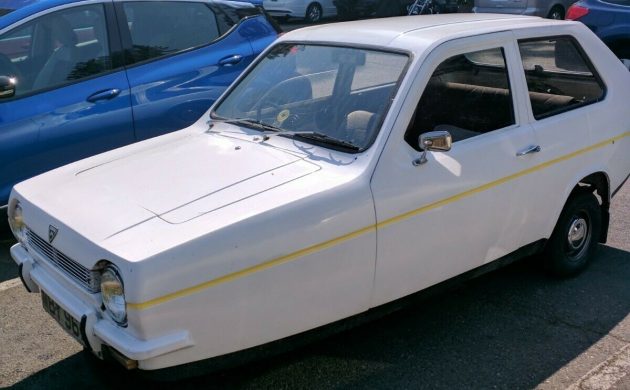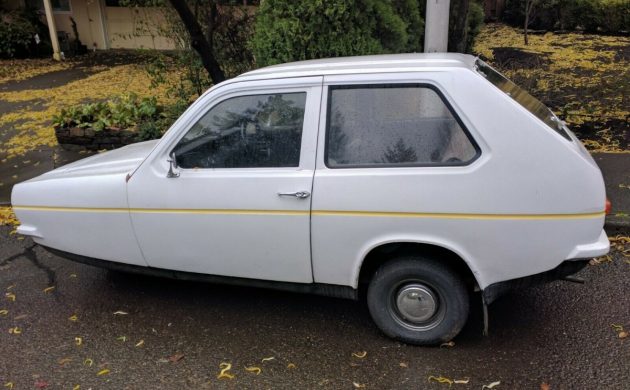For many people, especially outside the UK, the Reliant Robin first entered their consciousness via the TV series Top Gear. In its appearance on that show, it was repeatedly criticized for its lack of stability. The fact is that the Robin is not a particularly dangerous car, and the examples used in the show were specially weighted to ensure that they rolled over. This non-rolling Reliant could be yours because it is listed for sale here on eBay. Located in Lake Oswego, Oregon, bidding on the UK classic has now reached $2,280, and while the listing shows that the reserve hasn’t been met, the owner says that he has removed it on his wife’s urging, as the little car simply must sell.
The reality with the Robin is that it was actually one of those cars that just happened to be in the right place at the right time. Released in 1973 as a cheap and economical form of transport, the fact that it could easily achieve fuel consumption figures of 60mpg or more became vitally important when the Oil Crisis hit the world in October of 1973. Suddenly, fuel economy was vitally important, and this helped to cement the Robin’s place in the automotive market. In fact, the Robin’s success actually meant that it was the second most successful fiberglass-bodied car in the world, behind the Corvette. This particular Robin is a clean example that has been partially restored by its current owner. It still requires some cosmetic work, but the owner currently uses the car on a regular basis while work proceeds. The car appears to be structurally solid, with only some light surface corrosion on the underside. The fiberglass body has a few flaws, but these should be fairly easy to address. Overall, the car actually looks quite presentable.
Inside the Robin, there will be some cosmetic work required, but as stated earlier, it remains quite serviceable as it stands now. It will need new covers on the seats, new door trims, and new carpet. There is a knob missing off one control on the dash, but overall, the rest of the interior looks quite good. There are few luxuries inside a Robin, and this is well within character for a car of this type. It was designed to be cheap and affordable motoring, and its low purchase price left little room to fit too many luxury items.
When first released, the Robin featured a 750cc engine, but in 1975, this was upgraded to an 850cc 4-cylinder engine, producing 39hp. This power is sent to the rear wheels via a 4-speed manual transmission. Braking is achieved by 3-wheel drum brakes. The horsepower figure might seem low, but the Robin is actually a surprising little car. While economy of 60mpg was easily within reach, a top speed of 80mph was also available. As for stability, if a Robin is driven with any degree of common sense, then they are nowhere near as prone to “rolling over and playing dead” as they have been portrayed to be. The owner says that this particular Robin runs and drives well, and only needs a few minor issues addressed. It appears that the clutch is in need of some adjustment, while the left turn indicator works intermittently, as does the horn. The Reliant rolls on fairly new tires, which is a bit of a bonus.
A Reliant Robin isn’t for everyone, but thanks to the exploits of Top Gear, and regular appearances on the TV series Mr. Bean, they have become recognizable, especially outside the UK. They are not the unstable little car that they have been portrayed to be, and are actually a fun and entertaining little car. If you would love to own a cheap UK classic that will help you stand out, then this is a car that is seriously worth considering.







80 mph? That would take guts.
Aside from the famous rollover bits with Jeremy Clarkson at the wheel, there was also the time that Top Gear tried to turn a Reliant into a Space Shuttle…
https://www.youtube.com/watch?v=pJdrlWR-yFM
Then there’s this…..
youtube.com/watch?v=D2eTnwKGYT4
It is hard to roll one ( we know several people involved in the top gear episode).
The motorcycle licence usage was abolished in the 60’s (you then needed a full car licence).
Previously there were several criteria to meet this Inc no reverse gear & a max weight amongst others.
The blue one in Mr bean is the model before a regal super van MK3.
They were in the lower road tax bracket as they were registered as a tricycle.
They where used as sole transport by many families Inc holidays & long distances towing trailer tents.
A lot of what’s written/spoken is by people who’ve never even riden in one let alone driven one.
Similar to all corvairs end up upside down or backwards into the scenery.
Another reason that they were good sellers is that you only needed a motorcycle licence to be able to drive them, so at least the ex biker had a small degree of comfort while driving to work on one of the cold and wet days that we sometimes have here in the UK. (Yeah, right.)
If I don’t remember wrong the UK annual road tax system at the time was also based upon the number of wheels a vehicle had. Less wheels = less road wear = less tax ; which would make the Robin a cheap vehicle to own if one simply needed a simple shopping cart for local duties
Also true. There is a minimum weight requirement, but 3 wheelers are classed with motorcycles in UK, so only a bike license is required. Whilst that might have been a strong marketing position in pre-Beatles UK, by the 70s Reliant customers were usually repeat buyers.
I will be the first to say it…. ‘Busa swap!
Fortunately production ceased in 2002.Reliant did make some VERY good cars like the Sabre & Scimitar,but they had 4 wheels!
“They are not the unstable little car that they have been portrayed to be, and are actually a fun and entertaining little car.”
So wrong…..Just try one and see if you think it´s fun. If you survive, no-one will talk to you.
At least the Robin looked better than the Regal, which proceeded it. You have to love how 1960s England thought that you could sell anything with a snobby name……
There was a 4 wheel version of the Robin, the Reliant Kitten, which got converted into racing specials, one in particular being spectacularly effective. But then again, he used the station wagon version
http://marshallfraserracing.blogspot.com/p/1980s.html
You’ve omitted the 4 wheel Rebel,and the 4 wheel Fox pickup!
The best line from the Top Gear episode was when Clarkson interviewed someone from the Robin club and he said something to the effect that “the best strategy to keep them from tipping over is to try and drive them in a straight line.”
Proves the old adage, “Give an Englishman a piece of sheet metal and he’s bound to do something silly with it.”
The proper reference is to fiberglass. I should know: I once had a Daimler SP250! That made this little booger look downright gorgeous. The Kitten 4-wheeler, basically this with two wheels up front and full-width bodywork to match, was actually cute. And a lot prettier than a Mini. The engine for all of the little Reliants was a very nicely designed alloy ohv four-cylinder, also receptive to tuning mods.
ALL Reliants were fibreglass bodied,save for the first ones just after the war (google it & see).As I recall,they evolved from the Raleigh car,a Nottingham company who made motorcycles and later bicycles.For those of you who care,Reliant is still going,they just don’t make cars any more.
I’m tempted to paint it blue and make it like the car from Mr. Bean
I was just going to make the same reference, LOL!! :-)
I met the chief engineer at Reliant back in the early 1990s, as he was also working to import the new Tatra T-613 cars from the Czech Republic [I’ve had several Tatra cars]. He let me drive a 3-wheel reliant around and it was quite stable at higher speeds [I got it up to about 60mph].
What amazed me was how light weight the Robin engine was, he handed me a bare block without crank or internals, just the block, and it was only 7 pounds in weight. I felt as if it would float away if I let go of it! He said most of the Robin mechanical bits were designed & manufactured in-house by Reliant, and they were/are still quite reliable and easy to source parts for. The company still supplies parts for Reliant cars of all types, but the Tamworth, England factory is now a large housing development, known as “Scimitar”, the name of a Reliant sports car.
Up until the mid 1990s, Reliant was the second largest producer of vehicles in the UK, second only to British Leyland.
I would certainly prefer to be driving a later version of a Robin, than one of those little “Smart” cars.
I’d modify it back to a 4 wheeled car. I’d put a set up with front wheels outside the body with fenders similar to that used on a prowler then a suspension out of another car. Wait a minute no I wouldn’t I’d never buy this crapper in the first place. What was I thinking.
Sold for $3056.
No one mentioned Fools and Horses, Del boys Trotter enterprises survived on a Robin Van.
Didn’t The American Embassy In London buy them to run messages and errands as they were easy to park and cheap to run.
These were also the base for the futuristic looking Bond BUG no?
The Bug was made by Bond,who also made 3 & 4 wheeled cars.They started with the Minicar,which used a Villiers 2 stroke motorbike engine.To start them,you opened the bonnet(hood) and activated the kickstart lever with your foot.They went on to make the 875 3 wheeler,powered by a Hillman Imp engine – quick car!Bond went bust and were bought out by Reliant.
The trotter van was a regal supervan MK3 the model before the robin
1 less braking wheel – how are the brakes on this thing? Better be a disc brake on the front. lol
Does look a little futuristic.
Has anyone watched Robin Reliant racing on Youtube ? Those drivers are crazy !
don,
If you think they’re crazy, search youtube for Dutch backwards auto racing using DAF automobiles. The DAF cars used a variable belt drive automatic transmission, and it’s possible to fit a longer belt in a figure 8 instead of the normal oval, allowing high speed driving IN REVERSE.
Back in the 1970s I lived in Europe, and visited Holland to see the races live, it was wonderfully funny, but at the same time it was serious competition racing.